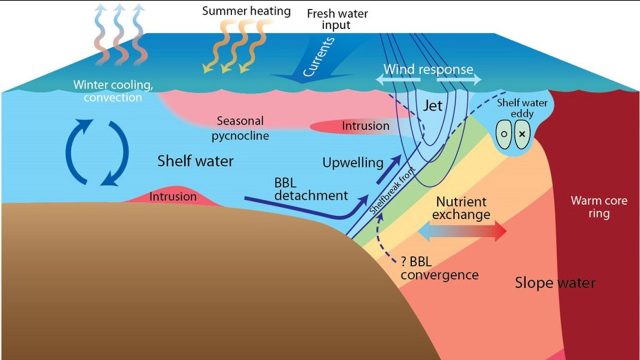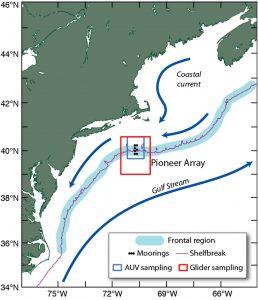Pioneer Array Design: Building on the known to explore the unknown
The location of the Ocean Observatories Initiative Pioneer Array has been ideal for understanding recent, unprecedented changes in temperature and ocean properties on the continental shelf and slope off the coast of New England, coincident with an increase in warm core rings at a time when the Gulf Stream has grown increasingly unstable. That’s the conclusion of a review paper published last month in the Journal of Operational Oceanography.
The paper, written by Glen Gawarkiewicz and Al Plueddemann of Woods Hole Oceanographic Institution, details how the components and location of the array were determined and how the data gathered there has changed scientific questions being asked in this critical region. The array also provides a unique observatory model that can be applied in other shelf break regions across the world.
“We already knew a fair bit about what was happening in the region, but what we’re seeing now isn’t what we expected,” said Plueddemann. “Fortunately, the array was designed and constructed in such a way that we were ready for just about anything.”
The shelf break front stretches along the U.S. Northeast Coast from Georges Bank to Cape Hatteras, dividing cooler, fresher waters of the coast and continental shelf from warm, saltier waters of the slope. It is a complex, productive, and constantly changing area, driven by the interaction of winds, currents, and offshore rings.
Prior to the Pioneer Array, data from the shelf break came primarily from stationary moored instruments or from short-term, mobile observations provided by ocean gliders and towed shipboard systems. In designing the Pioneer Array, scientists and engineers working with the NSF-funded Ocean Observatories Initiative integrated moorings, gliders and propeller-driven AUVs to provide a long-term, multi-dimensional data set that blends the advantages of multiple observing technologies. This is particularly important as ocean processes occurring at the shelf break occur on a variety of space and time scales.
Gawarkiewicz and Plueddemann point out that in addition to enabling new scientific discovery, data from the Pioneer Array has the potential for real-time applications to help track and forecast hurricanes and winter storms, improve search-and-rescue operations, and the siting and operation of off-shore wind installations.
Since becoming operational in 2016, the Pioneer Array has gathered near-continuous data across a 24,000 square-kilometer swath of the shelf break region. By combining moorings, gliders, and AUVs, the array has provided the scientific community with high-resolution observations across space and time, which are unprecedented in their scope and detail and are also freely available on the Ocean Observatories Initiative data portal.
“We haven’t even scratched the surface yet,” said Plueddemann. “There’s still lots of potential to mine in the Pioneer Array data.”
The Ocean Observatories Initiative (OOI) is a long-term infrastructure project funded by the National Science Foundation to gather physical, chemical, and biological data from the ocean, atmosphere, and seafloor and to deliver that data on demand and in near real-time online. The program includes fixed instruments and autonomous underwater vehicles deployed at key locations off in U.S. coastal waters and in the open ocean. The OOI currently maintains arrays off the Northeast and Northwest coasts of the U.S., the Irminger Sea southeast of Greenland, and at Station Papa in the Gulf of Alaska, as well as a seafloor cabled array off the coast of Oregon. Data from the arrays help researchers address questions ranging from rapidly changing weather events to long-term climate change and from air-sea interaction to sea floor processes. OOI is managed by the Woods Hole Oceanographic Institution (WHOI) and implemented by WHOI, the University of Washington, Oregon State University, and Rutgers, the State University of New Jersey.


